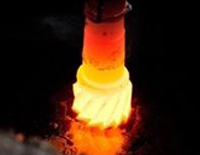Austempering Or Ausquenching

- AUSTEMPERING is the isothermal transformation of a ferrous alloy at a temperature below that of pearlite formation and above that of martensite formation.
- Austempering of steel and nodular cast iron offers several potential advantages:
- Increased ductility, toughness, and strength at a given hardness.
- Reduced distortion, which lessens subsequent machining time, stock removal, sorting, inspection, and scrap.
- The shortest overall time cycle to through-harden within the hardness range of 35 to 55 HRC, with resulting savings in energy and capital investment.
ADI offers this superior combination of properties because it can be cast like any other member of the Ductile Iron family, thus offering all the production advantages of a conventional Ductile Iron casting.
Subsequently it is subjected to the austempering process to produce mechanical properties that are superior to conventional ductile iron, cast and forged aluminum and many cast and forged steels.
The yield strength of ADI is over three times that of the best cast or forged aluminum. In addition ADI weighs only 2.4 times more than aluminum and is 2.3 times stiffer. ADI is also 10% less dense than steel.
The mechanical properties of Ductile Iron and ADI are primarily determined by the metal matrix. The matrix in conventional Ductile Iron is a controlled mixture of pearlite and ferrite. (Tempered martensitic matrices may be developed for wear resistance, but lack the ductility of either as-cast Ductile Iron or ADI).
The properties of ADI are due to its unique matrix of acicular ferrite and carbon stabilized austenite; called Ausferrite.

- MARTEMPERING also known as 'marquenching', this treatment uses an elevated temperature quench.
- Components are heated to the austenitizing temperature range and quenched, normally in molten salt at a temperature above the martensitic transformation start point (Ms).
- Components are held in the quenching medium for sufficient time until the temperature of the component is uniform and then air cooled through the martensite formation range.
- This is effectively a harden and temper operation at the same time, keeping distortion to a minimum. Subsequent tempering is carried out to improve the materials toughness.
Advantages:
Results in properties which combine good wear resistance, high strength, ductility and toughness with minimum distortion.
Furnace Size - (600 Ø X 800 mm Length)



